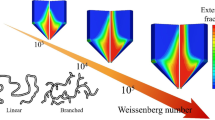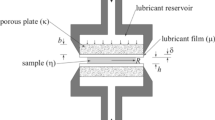Abstract
Flows involving different types of chain branches have been modelled as functions of the uniaxial elongation using the recently generated constitutive model and molecular dynamics for linear viscoelasticity of polymers. Previously control theory was applied to model the relationship between the relaxation modulus, dynamic and shear viscosity, transient flow effects, power law and Cox–Merz rule related to the molecular weight distribution (MWD) by melt calibration. Temperature dependences and dimensions of statistical chain tubes were also modelled. The present study investigated the elongational viscosity. We introduced earlier the rheologically effective distribution (RED), which relates very accurately and linearly to the viscoelastic properties. The newly introduced effective strain-hardening distribution (REDH) is related to long-chain branching. This REDH is converted to real long-chain branching distribution by melt calibration and a simple relation formula. The presented procedure is very effective at characterizing long-chain branches, and also provides information on their structure and distribution. Accurate simulations of the elongational viscosities of low-density polyethylene, linear low-density polyethylene and polypropylene, and new types of MWDs are presented. Models are presented for strain-hardening that includes the monotonic increase and overshoot effects. Since the correct behaviour at large Hencky strains is still unclear, these theoretical models may aid further research and measurements.











Similar content being viewed by others
References
Aho J, Rolón-Garrido VH, Syrjälä S, Wagner MH (2010) Measurement technique and data analysis of extensional viscosity for polymer melts by Sentmanat extensional rheometer (SER). Rheol Acta 49:359–370
Auhl D, Chambon P, McLeish TCB, Read DJ (2009) Elongational flow of blends of long and short polymers: effective stretch relaxation time. Phys Rev Lett 103:219801
Borg T (Muolon Oy) (2011) Method of producing a shrinkable product U.S. Patent 5,053,174, 1 Oct 1991
Borg T, Pääkkönen EJ (2009a) Linear viscoelastic models: part I. Relaxation modulus and melt calibration. J Non-Newton Fluid Mech 156:121–128
Borg T, Pääkkönen EJ (2009b) Linear viscoelastic models: part II. Recovery of the molecular weight distribution using viscosity data. J Non-Newton Fluid Mech 156:129–138
Borg T, Pääkkönen EJ (2009c) Linear viscoelastic models: part III. Start-up and transient flow effects from the molecular weight distribution. J Non-Newton Fluid Mech 159:17–25
Borg T, Pääkkönen EJ (2010) Linear viscoelastic models: part IV. From molecular dynamics to temperature and viscoelastic relations using control theory. J Non-Newton Fluid Mech 165:24–31
Burghelea TI, Starý Z, Münstedt H (2011) On the viscosity maximum during the uniaxial extension of a low density polyethylene. J Non-Newton Fluid Mech 166:1198–1209
Chen X, Costeux C, Larson RG (2010) Characterization and prediction of long-chain branching in commercial polyethylenes by a combination of rheology and modeling methods. J Rheol 54:1185–1206
Costeux S (2003) Modeling of randomly branched polymers produced by combination of several single-site catalysts: toward optimization of melt properties. Macromolecules 36:4168–4187
Costeux S, Wood-Adams P, Beigzadeh D (2002) Molecular structure of metallocene-catalyzed polyethylene: rheologically relevant representation of branching architecture in single catalyst and blended systems. Macromolecules 35:2514–2528
Doi M, Edwards SFJ (1978) Dynamics of concentrated polymer systems. Part 2. Molecular motion under flow. J. Chem Soc Faraday Trans 74:1802–1817
Doi M, Edwards SFJ (1979) Dynamics of concentrated polymer systems. Part 4. Rheological properties. Chem Soc Faraday Trans 75:38–54
Fleury G, Schlatter G, Muller R (2004) Non linear rheology for long chain branching characterization, comparison of two methodologies: fourier transform rheology and relaxation. Rheol Acta 44:174–187
Gabriel C, Münstedt H (2002) Influence of long-chain branches in polyethylenes on linear viscoelastic flow properties in shear. Rheol Acta 41:232–244
Gabriel C, Kokko E, Löfgren B, Seppälä J, Münstedt H (2002) Analytical and rheological characterization of long-chain branched metallocene-catalyzed ethylene homopolymers. Polymer 43:6383–6390
García-Franco CA, Srinivas S, Lohse DJ, Brant P (2001) Similarities between gelation and long chain branching viscoelastic behavior. Macromolecules 34:3115–3117
Hassager O, Marin JMR, Yu K, Rasmussen HK (2010) Polymeric liquids in extension: fluid mechanics or rheometry? Rheol Acta 49:543–554
Inkson NJ, McLeish TCB, Harlen OG, Groves DJ (1999) Molecular constitutive equations for a class of branched polymers: the pom-pom polymers. J Rheol 43:873–896
Keßner U, Kaschta J, Münstedt H (2009) Determination of method-invariant activation energies of long-chain branched low-density polyethylenes. J Rheol 53:1001–1016
Keßner U, Kaschta J, Stadler FJ, Le Duff CS, Drooghaag X, Münstedt H (2010) Thermorheological behavior of various short- and long-chain branched polyethylenes and their correlations with the molecular structure. Macromolecules 43:7341–7350
Kurzbeck S, Oster F, Münstedt H (1999) Rheological properties of two polypropylenes with different molecular structure. J Rheol 43:359–374
Laun HM (1978) Description of the non-linear shear behaviour of a low density polyethylene melt by means of an experimentally determined strain dependent memory function. Rheol Acta 17:1–15
Laun HM, Schuch H (1989) Transient elongational viscosities and drawability of polymer melts. J Rheol 33:119–175
Likhtman AE, Graham RS (2003) Simple constitutive equation for linear polymer melts derived from molecular theory: roli-poly equation. J Non-Newton Fluid Mech 114:1–12
Lohse DJ, Milner ST, Fetters LJ, Xenidou M, Hadjichristidis N, Menedelson RA, Garcia-Franco CA, Lyon MK (2002) Well-defined, model long chain branched polyethylene. 2. Melt rheological behavior. Macromolecules 35:3066–3075
Mackley M (2010) Stretching polymer chains. Rheol Acta 49:443–458
Malmberg A, Kokko E, Lehmus P, Löfgren B, Seppälä J (1998) Long-chain branched polyethene polymerized by metallocene catalysts Et[Ind]2ZrCl2/MAO and Et[IndH4]2ZrCl2/MAO. Macromolecules 31:8448–8454
Malmberg A, Liimatta J, Lehtinen A, Löfgren B (1999) Characteristics of long chain branching in ethene polymerization with single site catalysts. Macromolecules 32:6687–6696
Malmberg A, Gabriel C, Steffl T, Münstedt H, Löfgren B (2002) Long-chain branching in metallocene-catalyzed polyethylenes investigated by low oscillatory shear and uniaxial extensional rheometry. Macromolecules 35:1038–1048
McLeish TCB, Larson RG (1998) Molecular constitutive equations for a class of branched polymers: the pom-pom polymers. J Rheol 42:81–110
Meimaroglou D, Kiparissides C (2010) Macromolecules 43:5820–5832
Meimaroglou D, Krallis A, Saliakas V, Kiparissides C (2007) Macromolecules 40:2224–2234
Meissner J, Hostettler J (1994) A new elongational rheometer for polymer melts and other highly viscoelastic liquids. Rheol Acta 33:1–21
Münstedt H (1979) New universal extensional rheometer for polymer melts. J Rheol 23:421–436
Münstedt H, Kurzbeck S, Egersdörfer L (1998) Influence of molecular structure on rheological properties of polyethylenes part II. Elongational behavior. Rheol Acta 37:21–29
Münstedt H, Steffl T, Malmberg A (2005) Correlation between rheological behaviour in uniaxial elongation and film blowing properties of various polyethylenes. Rheol Acta 45:14–22
Münstedt H, Kurzbeck S, Stange J (2006) Importance of elongational properties of polymer melts for film blowing and thermoforming. Polym Eng Sci 46:1190–1195
Petrie CJS (2006) One hundred years of extensional flow. J Non-Newton Fluid Mech 137:1–14
Rasmussen HK, Nielsen JK, Bach A, Hassager O (2005) Viscosity overshoot in the start-up of uniaxial elongation of low density polyethylene melts. J Rheol 49:369–381
Rauschenberger V, Laun HM (1997) A recursive model for Rheotens tests. J Rheol 41:719–737
Rolón-Garrido VH, Wagner M H (2007) The MSF model: relation of nonlinear parameters to molecular structure of long-chain branched polymer melts. Rheol Acta 46:583–593
Rolón-Garrido VH, Pivokonsky R, Filip P, Zatloukal M, Wagner MH (2009) Modelling elongational and shear rheology of two LDPE melts. Rheol Acta 48:691–697
Sentmanat M (2004) Miniature universal testing platform: from extensional melt rheology to solid-state deformation behaviour. Rheol Acta 43:657–669
Soares JBP, Hamielec AE (1996) Bivariate chain length and long chain branching distribution for copolymerization of olefins and polyolefin chains containing terminal double bonds. Macromol Theory Simul 5:547–572
Stadler FJ, Kaschta J, Münstedt H, Becker F, Buback M (2009) Influence of molar mass distribution and long-chain branching on strain hardening of low density polyethylene. Rheol Acta 48:479–490
Starý Z, Münstedt H (2008) Morphology development in PS/LLDPE blend during and after elongational deformation. J Polym Sci Part B: Polym Phys 46:16–27
Sugimoto M, Suzuki Y, Hyun K, Ahn KH, Ushioda T, Nishioka A, Taniguchi T, Koyama K (2006) Melt rheology of long-chain-branched polypropylenes. Rheol Acta 46:33–44
Trinkle S, Walter P, Friedrich C (2002) Van Gurp–Palmen Plot II—classification of long chain branched polymers by their topology. Rheol Acta 41:103–113
van Gurp M, Palmen J (1998) Time temperature superposition of polymeric blends. Rheol Bull 67:5–8
van Ruymbeke E, Nielsen J, Hassager O (2010a) Linear and nonlinear viscoelastic properties of bidisperse linear polymers: mixing law and tube pressure effect. J Rheol 54:1155–1172
van Ruymbeke E, Muliawan EB, Hatzikiriakos SG, Watanabe T, Hirao A, Vlassopoulos D (2010b) Viscoelasticity and extensional rheology of model Cayley-tree polymers of different generations. J Rheol 54:643–662
Vega JF, Fernándes M, Santamariá A, Muñoz-Escalona A, Lafuente P (1999) Rheological criteria to characterize metallocene catalyzed polyethylenes. Macromol Chem Phys 200:2257–2268
Vega JF, Expósito MT, Martínez-Salazar J, Lobón-Poo M, Barcina JO, Martínez AG, López M (2011) Molecular architecture and linear viscoelasticity of homogeneous ethylene/styrene copolymers. Rheol Acta 50:207–220
Wagner MH (1979) Zur Netzwerktheorie von Polymer-Schmelzen. Rheol Acta 18:33–50
Wagner MH, Kheirandish S, Stange J, Münstedt H (2006) Modeling elongational viscosity of blends of linear and long-chain branched polypropylenes. Rheol Acta 46:211–221
Wood-Adams PM, Dealy JM (2000) Using rheological data to determine the branching level in metallocene polyethylenes. Macromolecules 33:7481–7488
Wood-Adams PM, Dealy JM, deGroot AW, Redwine OD (2000) Effect of molecular structure on the linear viscoelastic behavior of polyethylene. Macromolecules 33:7489–7499
Zimm BH, Stockmayer WH (1949) The dimensions of chain molecules containing branches and rings. J Chem Phys 17:1301–1314
Author information
Authors and Affiliations
Corresponding author
Rights and permissions
About this article
Cite this article
Borg, T., Pääkkönen, E.J. Linear viscoelastic model for elongational viscosity by control theory. Rheol Acta 51, 371–384 (2012). https://doi.org/10.1007/s00397-011-0598-2
Received:
Revised:
Accepted:
Published:
Issue Date:
DOI: https://doi.org/10.1007/s00397-011-0598-2




